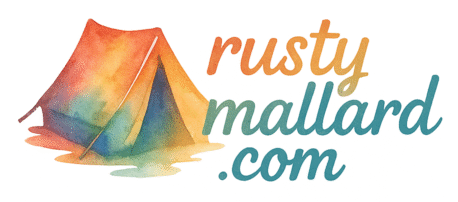Camping is all fun and s’mores—until someone steps on a sharp rock or touches a burning pan. Whether you’re a seasoned adventurer or testing the tent waters for the first time, first aid camping tips can literally save the day—or someone’s life. Let’s dive into six first aid must-knows that every camper, beginner or pro, should keep in their back pocket (or backpack).
Why First Aid Knowledge is Essential for Campers
Imagine you’re deep in the woods, phone signal weaker than your last coffee, and someone in your group slips and twists their ankle. You can’t just call an ambulance. Out here, you’re the first responder. That’s why understanding basic first aid is a non-negotiable camping skill. It helps you stay calm, respond quickly, and prevent a bad situation from turning worse.
You’ll also want to be familiar with common camping mistakes like not packing essentials or skipping emergency plans—check out Rusty Mallard’s camping tips and camping mistakes to avoid them all.
Tip #1: Build a Comprehensive First Aid Kit
What to Include in Your Camping First Aid Kit
Your camping first aid kit should be more than just a few band-aids and a hope. Here’s what you should never leave home without:
- Antiseptic wipes and antibiotic ointment
- Various sizes of bandages and gauze
- Tweezers and scissors
- Thermometer
- Pain relievers (ibuprofen, acetaminophen)
- Burn cream
- Allergy medication (like antihistamines)
- Medical gloves
- Emergency blanket
- CPR face shield
- Snake bite kit (depending on location)
Explore Rusty Mallard’s camping gear section for recommended first aid kits made for the outdoors.
Where to Store and How to Label It
Pack it in a waterproof container or bag, label it clearly, and make sure everyone in your group knows where it is. Pro tip: put it in the same place every trip so you build muscle memory.
Tip #2: Know How to Treat Common Camping Injuries
Cuts, Scrapes, and Bruises
Clean the wound with water (boiled and cooled if necessary), disinfect, and cover it. Sounds simple, but in the wild, hygiene is your first defense against infection.
Burns from Campfires or Stoves
Burns happen—don’t panic. Cool it immediately with clean, cold water for 10-15 minutes. Avoid popping blisters and wrap loosely. Burns are one of those things they don’t warn you about in marshmallow toasting tutorials.
Sprains, Strains, and Blisters
Follow the R.I.C.E method—Rest, Ice, Compression, Elevation—for sprains. For blisters, cover with a bandage and avoid popping unless necessary. Consider beginner tips for hiking to avoid blisters in the first place.

Tip #3: Learn Basic First Aid Skills Before You Go
Take a First Aid Course (Online or In-Person)
From YouTube to the Red Cross, there are tons of resources. Aim for courses tailored to outdoor situations, like wilderness first aid.
Practice CPR and Wound Dressing
You can’t fake confidence in an emergency. Practice CPR, how to wrap wounds, and how to treat burns. You can also follow the Rustic Lifestyle guide for down-to-earth living skills.
Tip #4: Prepare for Environmental Hazards
Dealing with Insect Bites and Stings
Mosquitoes, bees, and even ticks love campers. Carry antihistamines, hydrocortisone cream, and tick removers. Familiarize yourself with symptoms of allergic reactions and always know the signs of anaphylaxis.
Identifying Poisonous Plants
If it’s green and looks suspicious, it probably is. Learn to identify poison ivy, poison oak, and sumac. Apps like PlantSnap can help, but it’s best to do your homework ahead of time. Check out nature education resources for more.
Managing Hypothermia and Heat Stroke
Know the signs: shivering, confusion, slurred speech (hypothermia) or headache, nausea, rapid pulse (heat stroke). Always pack layers, electrolytes, and learn when to call it quits and seek help.
Tip #5: Create an Emergency Plan with Your Group
Communication & Check-In Protocols
Have a plan for checking in. Use walkie-talkies, set meeting times, or try location-sharing devices like Garmin InReach. Make sure everyone knows the plan before setting up that tent.
What to Do If Someone Gets Lost or Hurt
Set a meeting point, teach others how to use a compass or GPS, and agree on a “help” signal (like three whistles). Get more advice from the outdoor advice tag.
Tip #6: Keep First Aid Information Easily Accessible
Emergency Contact Numbers & Location Markers
Keep a laminated card in your first aid kit with local emergency numbers, campsite address, and GPS coordinates. It’s a small thing that can make a huge difference.
Digital vs Paper: What Works Best in the Outdoors
Apps are great—until your battery dies. Always bring a hard copy of emergency instructions and basic first aid info. Trust us, your future self will thank you.
Wrapping It All Up: Be Smart, Be Safe
You don’t need to be a wilderness medic, but knowing these first aid camping tips can make your outdoor adventures way safer and a whole lot less stressful. It’s about being prepared, not paranoid. Whether you’re heading to a popular camping destination or wandering off the beaten trail, taking safety seriously helps you enjoy the freedom of nature without fear.
Want more beginner-friendly content? Swing by Rusty Mallard’s beginner camping tag and get inspired for your next adventure.
FAQs
1. What’s the most important item in a camping first aid kit?
The most important item is what you use most often—usually antiseptic and bandages. But don’t skip things like antihistamines or a CPR mask.
2. How often should I check my first aid kit before camping?
Check your kit before every trip. Replace expired meds and restock used supplies.
3. Should kids learn basic first aid too?
Absolutely! Teaching kids what to do in emergencies empowers them and could make all the difference one day.
4. Are there first aid kits made specifically for camping?
Yes, and they’re usually waterproof, compact, and built for multiple injury types. Check Rusty Mallard’s camping gear for top picks.
5. What should I do in case of an allergic reaction while camping?
Use antihistamines immediately. If symptoms worsen, administer an epinephrine pen if available and seek medical help ASAP.
6. How do I treat insect bites naturally?
Aloe vera, baking soda paste, or even a dab of toothpaste can reduce swelling and itching temporarily.
7. Where can I learn more about outdoor safety and survival?
You’ll find a goldmine of info under survival, outdoors, and life lessons tags on Rusty Mallard.


